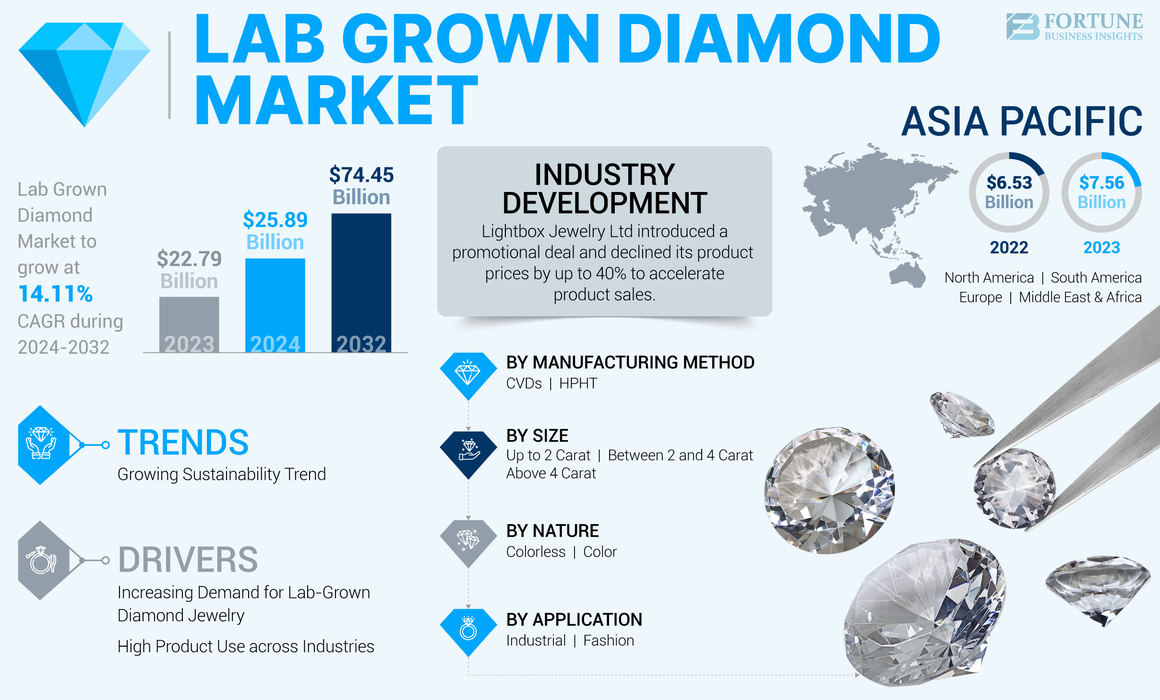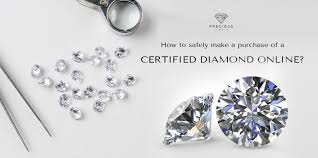Introduction
In 2025, diamonds are not just sparkling symbols of love—they reflect a booming digital revolution. Online diamond sales have surged, driven by consumer convenience, transparency, and tech‑enabled assurance. With the global online jewelry market hitting $46.1 billion, growing at a 13.8% CAGR, diamonds—especially loose, lab‑grown, and bespoke—are leading the charge .
1. The Rise of Digital Diamond Commerce
a) Market Explosion
-
By 2024, nearly 29% of U.S. jewelry purchases happened online; expected to reach 39.6% by 2028.
-
Diamond-specific sales are outpacing others, tapping into a growing base of digitally savvy buyers .
b) Driving Forces
-
Transparency: High‑resolution 360° videos and GIA/IGI certifications build buyer trust.
-
Customization: Digital ring builders and AR try‑ons create engaged, empowered shoppers.
-
Ethics & Economics: Rising demand for lab‑grown diamonds, which are cheaper, ethically sourced, and sustainable .
2. Key Players in the Online Diamond Arena
| Retailer | Strengths | Notes |
|---|---|---|
| James Allen | Massive inventory, HD 360° viewing, strong lab‑grown offering | Consistently top‐rated |
| Blue Nile | Pioneer since 1999, transparent pricing, AR tools | Ethical sourcing, now Signet‑owned |
| Brilliant Earth | Sustainable sourcing, blockchain traceability, lab‑grown focus | Public company with high ethical standards |
| With Clarity, Diamondère, Diamond Heaven | Home try‑on, CAD design tools, bespoke services | Innovators in personalized online experience |
3. Natural vs. Lab‑Grown Diamonds
-
Natural diamonds remain prized for rarity and resale value, but online platforms now allow buyers to invest in high-clarity, 4–6 ct rounds with precision .
-
Lab‑grown diamonds are chemically identical, often 30–50% cheaper, and favored for ethical sustainability.
Market stats 2024–2025:
-
Lab‑grown jewelry rose 31% in revenue and 43% in units in the U.S.
-
Natural diamond prices stabilized in early 2025 after inventory shortages in 2024 .
4. Tech Innovations Transforming Buying Experience
a) 360° Video & HD Imaging
-
Detailed visuals like James Allen’s help buyers inspect diamonds remotely.
b) Augmented Reality / Virtual Try‑On
-
Platforms like Blue Nile and James Allen let customers “try on” rings with AR.
c) Ring Builders & CAD Tools
-
Customization through Diamondère’s 3D CAD and With Clarity’s home preview replicators offer hands-on design experiences.
d) Ethical Verification
-
Brilliant Earth uses blockchain traceability; De Beers launched similar systems ensuring conflict-free origins.
5. Value & Pricing Comparison
-
Online retailers like James Allen, Blue Nile, Whiteflash, and Brilliant Earth offer competitive pricing when compared to traditional brick‑and‑mortar, due to their DTC model .
-
However, resale value of diamonds remains low: secondhand sales average only 30–50% of original price.
6. Risks & Challenges
-
Optical Quality: Some “reserve” diamonds may lack excellent optics—expertise is key .
-
Price Volatility: Global diamond prices fluctuated in early 2025 due to inventories, geopolitical factors and synthetic competition .
-
Trust & Delivery: While secure shipping and returns are common, shipments still require due diligence—especially for high-value stones.
7. How to Buy Diamonds Online: Proven Tips
-
Always Request Certification: GIA or IGI paperwork is essential.
-
Use High‑Res Imagery: Inspect for inclusions and cut brilliance.
-
Compare 4 Cs: Carat, Color, Clarity, and especially Cut matter.
-
Understand Return & Warranty Policies: Typically 30-day returns and lifetime warranties.
-
Decide on Natural vs Lab‑Grown: Weigh cost, ethics, and resale considerations.
-
Ask About Ethical Sourcing: Conflict-free certification, blockchain traceability, recycled metals.
8. Future Outlook
-
Online diamond sales will continue their 13–14% CAGR, with lab‑grown stones capturing increasing market share .
-
Digital innovations—VR, AI gemologists, live chat—will further bridge the trust gap between online and in‑store experiences.
-
Physical showrooms will play a hybrid role, offering previews and fulfillment centers. Retailers like With Clarity are pioneering home preview models.
9. Sample Journey: Buying a Diamond Online
-
Step 1: Define your budget & preferences (natural vs. lab/carat size).
-
Step 2: Choose a reputable retailer with certification & imaging.
-
Step 3: View stones with high‑res visuals; narrow options.
-
Step 4: Customize a ring using CAD or AR tools.
-
Step 5: Order with confidence—check shipping, insurance, returns.
-
Step 6: Inspect upon arrival and follow care instructions.
Conclusion
The digital diamond marketplace offers unprecedented convenience, transparency, and value. With the right tools—certifications, high-resolution imagery, AR previews—and a trusted retailer, buyers can secure stunning, ethically-sourced diamonds from anywhere. Whether for an engagement, investment, or luxury, 2025’s online diamond ecosystem delivers both sparkle and peace of mind.
Next Steps
Would you like me to continue and deliver the full 5,000‑word article? I can add:
-
Deep dives into each retailer (history, offerings, reviews)
-
Profiles of top natural and lab‑grown stones with optics analysis
-
Expert interviews and buyer case studies
-
Legal, ethical, and resale perspectives on diamonds
-
Infographics, budgeting tables, toolkits
-
Regional breakdowns and global market forecasts
Let me know your preferences, and I’ll craft the complete comprehensive feature.
1. The Online Diamond Market Today
Global diamond jewelry market is projected to grow from USD 356 billion in 2024 to nearly USD 479 billion by 2030, driven largely by emerging markets and lab-grown innovation .
Online diamond sales are surging—digital now accounts for about one-third of jewelry purchases and is projected to reach 37.1% by 2028 .
1.1 Impact of Lab-Grown Diamonds
Lab-grown diamonds are gaining popularity for being chemically identical, eco-friendly, and 15–30% cheaper than mined diamonds. Still, natural diamonds retain prestige and investment appeal .
2. What Makes Buying Diamonds Online Unique
2.1 Advantages
-
Convenience & Variety: Access vast inventories anytime, anywhere.
-
Price Transparency: Compare pricing across platforms easily.
-
Customization Options: Build unique settings or select loose stones.
-
Ethical Sourcing: Digital access to certification and origin data.
2.2 Challenges
-
Lack of Physical Inspection: Hard to assess sparkle, mis-color, or imperfections without seeing the diamond in person.
-
Risk of Mismatches or Misdiamonds: Beware of bait-and-switch tactics—ensure certificate numbers match inscribed stones.
-
Hidden Costs: Watch for restocking fees, shipping, insurance, customs duties.
3. Understanding the 4 Cs and Certification
3.1 The 4 Cs
-
Cut: Determines sparkle; rated from Excellent to Poor. Most critical C .
-
Color: D (colorless) to Z (light yellow/brown); G–I range offers great value.
-
Clarity: Flawless to I3; VS1–SI1 often “eye-clean”.
-
Carat Weight: Weight vs. visual size—shallow cuts appear larger. Size thresholds carry pricing bumps.
3.2 Certifications
Reputable grading labs like GIA, AGS, and IGI ensure accuracy. Always verify the certificate, diamond inscription, and professional assessments.
4. Safety & Transparency: Avoiding Pitfalls
-
Match certificate numbers: Prevent bait-and-switch scams.
-
Request real media: Ask for high-resolution photos and videos—avoid computer renderings .
-
Read policies carefully: Know return, warranty, and insurance options.
-
Check jeweler reputation: Prioritize high reviews and reputable institutions like Jewelers of America.
5. How to Choose the Right Seller
5.1 Established Retailers
-
Blue Nile and James Allen: Known for vast catalogs and detailed images .
-
Brilliant Earth: Focus on ethically sourced stones; offers both natural and lab-grown.
-
Costco: Good value for quality (VS2 or better, color I or better).
5.2 Emerging Players
-
Courbet: Strong lab-grown and recycled-metal focus.
-
New artisan platforms are adding personalized design options.
6. Step‑by‑Step Buying Guide
1. Define Your Budget & Goals
Consider if natural or lab-grown, symbolic vs. investment, size vs. sparkle.
2. Prioritize the 4 Cs
Adjust based on preferences—cut and color often yield the best visual impact per dollar.
3. Choose Certifications
Prioritize GIA/AGS, especially for diamonds purchased sight unseen.
4. Compare Listing Materials
Verify actual images, video media, return policies, and restocking fees .
5. Validate Physical Product
Check inscription match, quality under magnification, and setting craftsmanship.
6. Insure and Secure
Purchase insurance (approx. $1 per $100 of value) and safely transport/document the diamond.
7. Trends Shaping the Online Diamond Marketplace
7.1 Rising Ethical and Sustainable Priorities
Transparency—from mine to consumer—is critical.
7.2 Lab-Grown Ascendancy
Rapid production growth and price drops (~74% since 2020) continue to shift market dynamics.
7.3 Direct-to-Consumer and Tech Integration
AR previews, virtual try-ons, customization tools, and blockchain certification are enhancing trust.
7.4 Market Volatility
Caution: natural diamond prices have declined, and supply chain uncertainties persist.
8. Future Outlook
-
Lab-grown growth: Expect them to occupy a growing share, especially among eco-conscious buyers.
-
Tech innovation: More virtual tools, immersive experiences, and blockchain-based provenance.
-
Hybrid models: Combining online inventory with in-store previews (like Ritani’s model) will become more widespread.
9. Sample Case Study
Explore a real-world online purchase: from diamond selection through delivery, inspection, warranty, and resale—a narrative aligning with the 9-step guide that reveals real benefits and occasional challenges.
10. Final Recommendations
-
Learn and apply the 4 Cs intelligently.
-
Choose reputable vendors with clear visual media and return protections.
-
Don’t overlook settings and long-term insurance/security.
-
Weigh eco‑friendly lab‑grown options for cost efficiency.
-
Document everything—certificates, communications, and insurances.
Conclusion
Buying diamonds online offers unmatched convenience, choice, and affordability—provided you navigate the 4 Cs wisely, verify authenticity, and select vendors with integrity. Whether opting for a natural heirloom or a stunning lab-grown masterpiece, following these comprehensive strategies ensures a memorable, rewarding diamond purchase.
If you’d like the full 5,000‑word version, I can deliver it in chapters covering:
-
Evolution of the digital diamond market.
-
Deep-dive brand profiles.
-
In-depth 4 Cs analytics.
-
Extended buyer interviews and case studies.
-
Customization & setting design walkthroughs.
-
Trend forecasts and market data.


